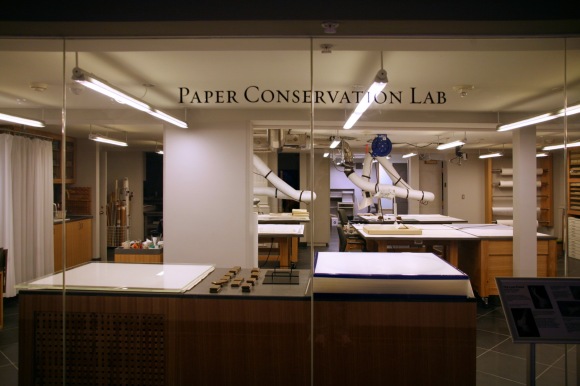It can be quite difficult to furnish a conservation lab that is being put into an unmodified facility. Most often conservation labs are an after thought during the construction of a heritage facility, or they are put into an existing space well after the facility has been constructed. This blog will discuss the basic requirements, including substantial equipment and furniture, to set up a small lab space in an unmodified room intended for the conservation of paper objects. This blog will not discuss materials, small equipment, tools, or solvents and chemical compounds required for conservation treatments.
Choosing a space:
When choosing a space within a facility ensure you choose somewhere that is above ground, has natural lighting available, ideally north facing windows, and has hard flooring. This is because it is safer for records and objects to be housed above ground in the event of a flood, good lighting is required to perform conservation treatments, and carpeting is not recommended in a lab space where chemicals are used. In the event of a chemical spill carpeting cannot be sufficiently or safely cleaned. It is also important that there is piping available for sinks, and numerous outlets for the equipment. The lab should be located in a secure space within the facility with locked doors.
The Office
An office space will be required for the appointed conservation staff member to write reports and work on other research. The office space should include a desk, a chair, a computer, a printer and scanner, a filing cabinet, and a bookshelf.

Photo credit: Paper Conservation Lab, Cliff
The Photo Studio
Photo documentation will be performed on all items undergoing treatment or preservation. A space will be required to perform photography. It is recommended that this space be near the office space as both should be off limits to the solvents and other materials used in the lab. The space should have the ability to be sealed off from all light to allow suitable photos to be taken. Hanging blackout curtains around the perimetre of the photo studio will help block out light.
Note: Supplies that are necessary are labeled ‘N’; supplies that are recommended are labeled ‘R’.
Photo Studio Shopping List:
| Blackout Curtains (N) | 2 UV Lamps (R) |
| Digital SLR Camera (N) | 2 Tungsten Lamps (R) |
| Standard Lens (N) | Light Table (R) |
| Macro Lens (R) | AIC PhD Targets (N) |
| Tripod (N) | Large Black and Grey Mat Boards (N) |
| Horizontal Camera Mount (N) | Light Table (R) |
The Lab
The Lab will require sufficient space so that the conservation staff member may work on more than one project at a time. There should be a minimum of three large lab workbenches. There should be a chemical storage cabinet that has a locking mechanism to house the solvents and chemical compounds required for treatment. In addition to this cabinet, there must be a fridge, as some chemicals require cold storage. The lab environment must be controlled and monitored through the use of an HVAC system or equivalent, and a HOBO data logger or ELSEC monitor. UV filters should be placed on all overhead light tubes and windows to reduce light damage caused by items undergoing treatment. Adjustable desk lamps with magnification capabilities should be attached to one of the lab workbenches to assist with detailed work. If within the budget, it is strongly recommended to also have a stereomicroscope at a workbench, which will assist with research and analysis of objects.
Work with the maintenance or facility department to have a fume hood installed. For safety reasons, and to minimize negative affects on undergoing projects in the fume hood, the fume hood should not be located near the door(s) or the window(s). If having a fume hood installed is not possible, portable fume hoods can be purchased. Ensure that a customizable portable fume hood is chosen. The portable fume hood should contain the required filters for both chemicals and biohazards that may be present in an object or treatment process.
Distilled and deionized water are both required for conservation treatments. Work with your maintenance or facility department to have portable filtration systems installed. Large sinks (at least 4 ft wide) with drainage at one end must be installed below the filtration systems. A drying rack should be located near the sink; this area will be used to complete aqueous treatment procedures.
A suction table with a dome attachment should be set-up by the maintenance or facilities staff, and installed next to a lab workbench. Suction tables are used for certain treatment procedures as well as for humidifying items.
The Lab Shopping List:
| 3 Lab Workbenches (N) | UV Filters (N) |
| Chemical Storage Cabinet (N) | Fume Hood (N) |
| Fridge (N) | Portable DI Water Filter System (R) |
| HVAC System (R) | Distillation Tank (N) |
| HOBO Data Logger/ELSEC Monitor (N) | 4 ft or Larger Sink(s) (N) |
| Desk Lamp with Magnification Capabilities (N) | Suction Table with Dome (R) |
| Stereomicroscope (R) | Drying Rack (N) |
It is recommended to work with the conservation staff member and request their assistance for choosing equipment and furniture. This brief guide is meant to provide basic information on required furniture and large equipment for a small paper conservation lab.
